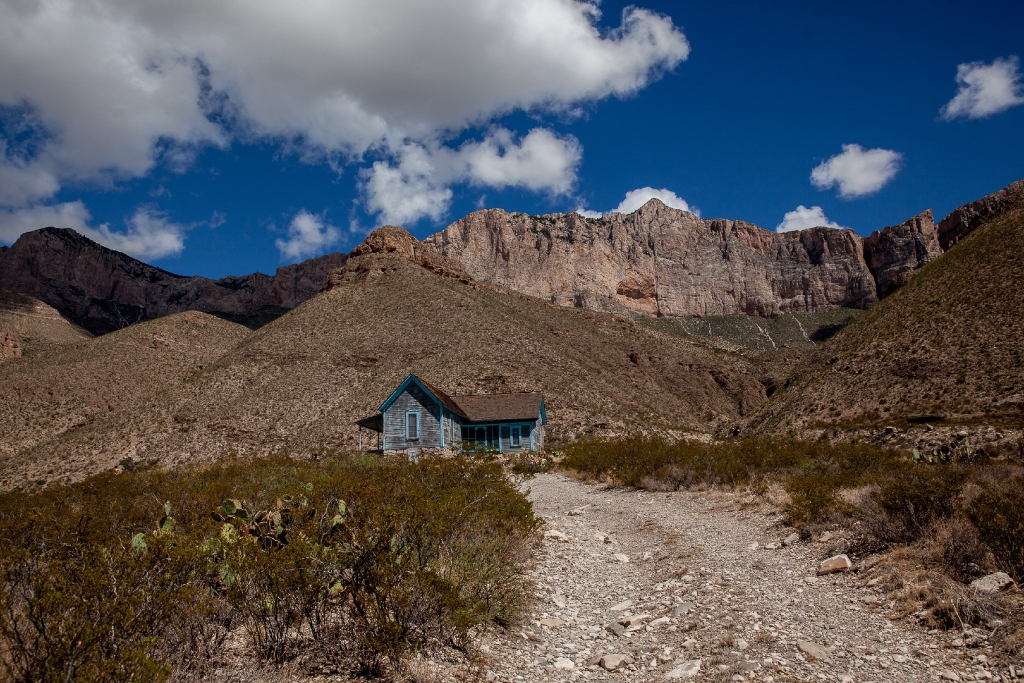
The Williams Ranch Road is currently closed.
The Williams Ranch Road is closed to all public access at this time due to severe damage and dangerous conditions. This closure includes public access by foot, vehicle, mountain bike, and stock traffic.
Heavy rains in the summer of 2021 caused extensive damage to the road, rendering it impassable for 4x4 vehicles. This closure is enacted to allow staff time to develop appropriate planning and compliance actions in order to address road conditions and return the road to safe condition efficiently.
The Williams Ranch can currently be reached by hikers via the El Capitan Trail from Pine Springs.
The Williams Ranch house was built in 1908 using both materials hauled from Van Horn, Texas and locally procured stone. The historical record suggests the ranch house was commissioned by Robert Belcher; however, it was his brother, Henry, along with his wife and daughter who settled there. The family established a longhorn ranching operation at the site. Around 1917 the property was transferred to James Adolphous "Dolph" Williams, who raised cattle, sheep, and goats and farmed on a small scale with his partner and friend Geronimo Segura until 1941.
In January of 1934, Roger Toll, Superintendent of Yellowstone National Park, and Judge Jesse Hunter, who was interested in developing a national park from his land holdings, toured the western sectors of the area. They researched ownership and contacts but found that there was an unwillingness on the part of various owners to sell property to the Federal Government. At the time, El Capitan was owned Dolph Williams.
Williams seems to have lived a fairly spartan life. Rather than replacing the wallpaper, he patched it with newspapers. Accounts from other pioneers of the area attest that this practice was common as a way to keep the wind and dust from blowing through the walls. Faced with harsh economic and environmental conditions, Williams sold the property to J. C. Hunter. Williams died in New Mexico in 1942.
After the Guadalupe Mountains National Park was authorized in 1966, J.C. Hunter Jr. sold his extensive land holdings, including the Williams Ranch site, to the Department of the Interior, expanding the size of the park. The park was formally established in 1972, and the Williams Ranch has been maintained by the National Park Service since then.
The Williams Ranch house is one of few remnants of the historic ranching operations in the area. In addition to its association with longhorn ranching and the broad social patterns brought on by the Dust Bowl Era, the ranch house is significant due to its unique architectural style.
The architectural style is Victorian but contains vernacular elements, including incorporation of local materials. The single-story house has an L-shaped floor plan and sits on a stone foundation. The thin walls are of box-and-strip construction finished with Boston clinker siding. The gabled roof is finished with wood shingles. A covered porch protrudes from the north facyade and a screened-porch is incorporated into the west side of the house. Decorative trim and lathed posts on the north porch are Victorian elements that add character. On the interior, the simple vertical wood plank walls and ceilings were hung with ornately patterned wallpaper, a character-defining feature.
The geology of the Capitan Reef and Forebasin contributed to the building's appearance and construction. The construction of the foundation is oflocal sandstone is important in terms of character, as it anchors the structure to the site with the use of the native material. In addition to the inclusion of locally sourced materials, the house contains unique architectural features that are vernacular in nature. For instance, the door and window frames are significantly thicker than the simple box-and-strip walls and protrude well beyond the wall surface on the interior of the house .
The panoramic west facing view from the Williams Ranch porch has changed dramatically over the last ninety years. Although the story of the human endeavor here is only vaguely reconstructed, this singular place contributes far more than a mere physical or textbook record. Its silent eloquence may stir time-worn feelings and engender a profound appreciation for all that once was. Above all, it evokes a bittersweet yearning for a time of simplicity and beauty that will never be again.
Is there something we missed for this itinerary?
Itineraries across USA

Acadia

Arches National Park

Badlands

Big Bend

Biscayne

Black Canyon Of The Gunnison

Bryce Canyon

Canyonlands

Capitol Reef

Carlsbad Caverns

Channel Islands

Congaree

Crater Lake

Cuyahoga Valley

Death Valley

Dry Tortugas

Everglades

Gateway Arch

Glacier

Grand Canyon

Grand Teton

Great Basin

Great Smoky Mountains

Guadalupe Mountains

Haleakalā

Hawaiʻi Volcanoes

Hot Springs

Indiana Dunes

Isle Royale

Joshua Tree

Kenai Fjords

Kobuk Valley

Lassen Volcanic

Mammoth Cave

Mesa Verde

Mount Rainier

North Cascades

Olympic

Petrified Forest

Pinnacles

Rocky Mountain

Saguaro

Shenandoah

Theodore Roosevelt

Virgin Islands

Voyageurs

White Sands

Wind Cave

Yellowstone

Yosemite

Zion